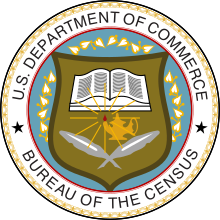
Back تعداد الولايات المتحدة 1920 Arabic Cens dels Estats Units del 1920 Catalan United States Census 1920 German Censo de los Estados Unidos de 1920 Spanish سرشماری ۱۹۲۰ ایالات متحده آمریکا Persian Recensement des États-Unis de 1920 French Sensus Amerika Serikat 1920 ID Censimento degli Stati Uniti d'America del 1920 Italian 1920년 미국 인구 조사 Korean Censo dos Estados Unidos de 1920 Portuguese
| Fourteenth census of the United States | ||
|---|---|---|
| ||
 U.S. Census Bureau seal | ||
| General information | ||
| Country | United States | |
| Results | ||
| Total population | 106,021,537 ( | |
| Most populous | New York 10,385,227 | |
| Least populous | Nevada 77,407 | |
The 1920 United States census, conducted by the Census Bureau during one month from January 5, 1920, determined the resident population of the United States to be 106,021,537, an increase of 15.0 percent over the 92,228,496 persons enumerated during the 1910 census.
Despite the constitutional requirement that House seats be reapportioned to the states respective of their population every ten years according to the census, members of Congress failed to agree on a reapportionment plan following this census, and the distribution of seats from the 1910 census remained in effect until 1933. In 1929, Congress passed the Reapportionment Act of 1929 which provided for a permanent method of reapportionment and fixed the number of representatives at 435.
This was the first census in which the United States recorded a population of more than 100 million. It was also the first census in which a state—New York—recorded a population of more than ten million.
This census also marked a significant population shift from rural to urban. According to the Census Bureau, "Beginning in 1910, the minimum population threshold to be categorized as an urban place was set at 2,500. "Urban" was defined as including all territory, persons, and housing units within an incorporated area that met the population threshold. The 1920 census marked the first time in which over 50 percent of the U.S. population was defined as "urban."[1]
- ^ "History: Urban and Rural". United States Census Bureau. Retrieved June 16, 2020.
© MMXXIII Rich X Search. We shall prevail. All rights reserved. Rich X Search